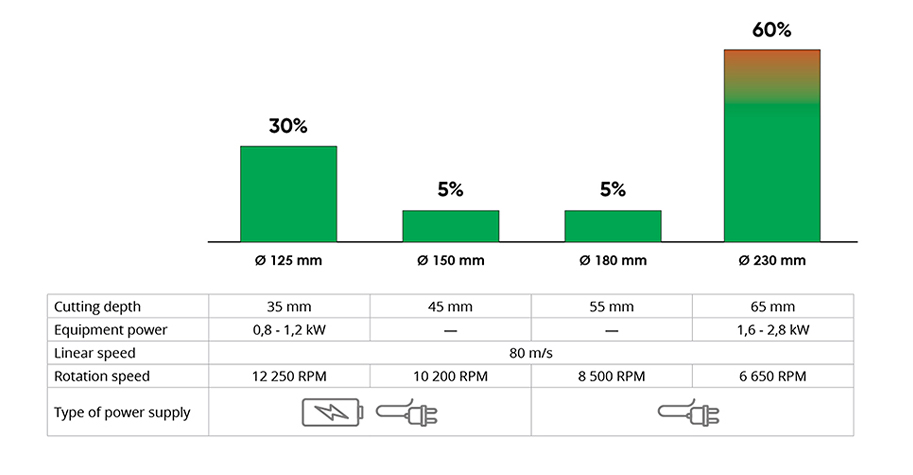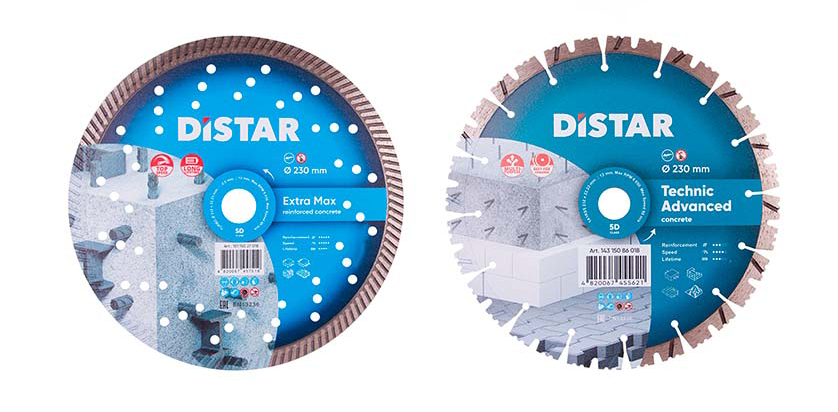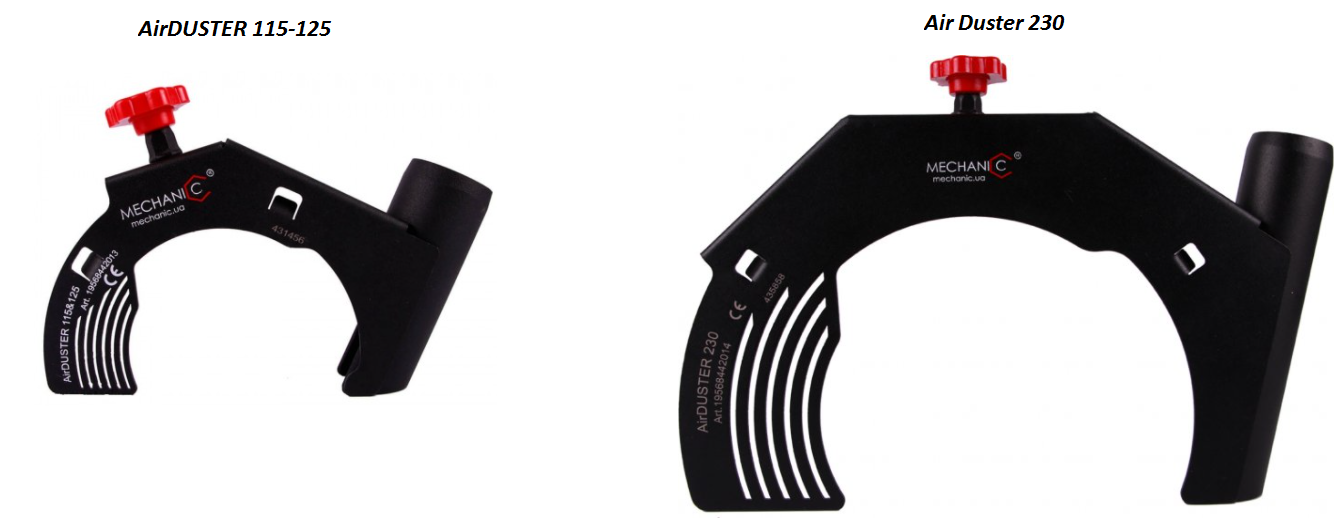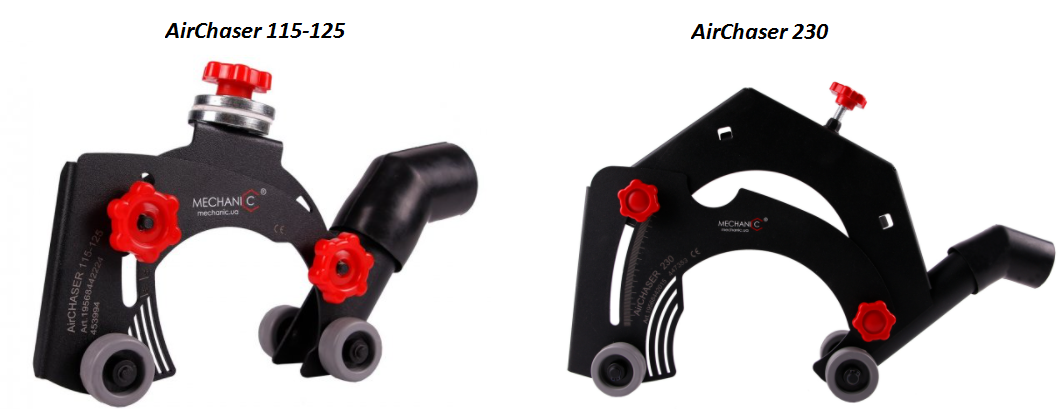Cutting construction materials on an angle grinder

Cutting construction materials is conventionally divided into 2 subgroups – indoors and outdoors. Often interior works are rough and will be hidden in the future, so for their processing it's possible to choose economical blades.
In this case, economical means diamond blades with high processing speed and good service life. Outside the building are performed as rough work that will be hidden, and those, that will later be visible and, accordingly, should be performed more qualitatively.
A huge percentage of construction material cutting work is done on angle grinders, and a small part on other types of equipment, such as electric cutters, wall chasers, and more. In this article we'll delve into the topic of cutting construction materials on an angle grinder.
Equipment for cutting construction materials.
Now the market offers a variety of different angle grinders by the diameter of the used blade, by power, and even with different types of power supply (corded and cordless).
Almost all of them relate to the linear rotation speed of a blade - 80 m/s. There are a total of four types of angle grinders according to the size of the consumables to be installed:
- 125 diameter. Their maximum cutting depth is 30-35 mm. Often they have a power of 0.8-1.2 kW, but there are also more powerful and expensive ones, with power up to 1.7 kW. They mostly work at speeds from 10 000 to 12 250 RPM and occupy almost one-third of the angle grinder market.
- 150 diameter. A very unpopular model type, having up to 5% of the market. The power of this type ranges from 1 kW to 1.7 kW. They give a cutting depth of up to 45 mm and operate at speeds up to 10,000 RPM.
- 180 diameter. Like the previous one, they are very unpopular and also have up to 5% of the market. Even more powerful than the previous examples - reach up to 2.0 kW. Cutting depth is up to 55 mm. Operate at blade's speed up to 8500 RPM.
- 230 diameter. The most popular and widespread type of angle grinder, occupies 60% of the total. Their power reaches 2.8 kW and even more. They give the largest cutting depth – up to 65 mm and work at shaft speeds up to 6550 RPM.

The most commonly used angle grinder has 125 and 230 diameters, together they share 90% of the market, so next we will focus mainly on them. Depending on the cutting depth, they can perform certain tasks.
Performed operations.
It has already been mentioned above that all operations of this type can be conditionally divided into 2 categories – internal and external. Let's take a closer look at which basic operations are done indoors, and which ones are done outdoors.
-
Internal.
- Cutting of door and window openings.
- Cutting blocks and lintel.
- Chasing for electricity and water supply.
- Demolition of large construction elements.
- Cutting of refractory bricks for the arrangement of stoves and fireplaces.
-
External.
- Cutting of socle or parts overlapping the facade.
- Cutting ceramic pipes.
- Cutting paving stones and curbs.
- Cutting slate and roof tiles.
- Cutting of cladding materials - bricks, sandstone.
Some of these tasks require the cleanest possible cut, as they will be visible, but most of them will be later hidden, so there are no quality requirements for the cut. All of these operations are performed on different materials, and it is very important to understand how is handled each one.
Machinability of the material.
Machinability is a value that can be used to characterize the speed and service life with which a diamond blade cuts through a particular material. It depends to a large extent on the abrasiveness and hardness of the construction material. The lower the hardness, the higher the abrasiveness.

Using this table, you can navigate how well the most common materials in a construction area will be processed. Abrasiveness strongly affects not only the processing speed, but also the tool resource, since abrasive particles ensure constantly wear of the diamond-bearing layer, and thus reduce the resource.
For this reason, it is better to use inexpensive blades with a maximum resource on such materials. But if the material we are working on has a high hardness and low abrasiveness, it is necessary to choose a specialized diamond consumable blade, whose composition is optimized for such tasks. The cheapest and simplest blades are 99% likely to fail with hard and highly reinforced concrete.
Based on the figure above, we can easily select the optimal blade for the processing material we're working with.
Blade selection.
All construction materials can be conventionally divided into 3 categories, according to their machinability and depending on this select a blade.
Highly abrasive, non-solid materials. This category may include stucco, concrete roof tiles, curbs with dry-compressed concrete, and many kinds of bricks (silicate, fireclay, rough red, and many others).
Due to the high abrasiveness of these materials, they will be easy to handle, and it does not make sense to buy expensive blades for them. The blades of TM "Baumesser" and TM "Distar" 3-D class (Universal or Beton Pro) are excellent for cutting such materials. If the amount of work is relatively small, it is better to stop on blades from Baumesser, but if we need more resourceful ones - Distar is our choice.
Medium abrasive materials. Such materials include facing bricks, sandstone, non-reinforced or weakly reinforced concrete, paving slabs, curbs and others. Since their processing is more difficult than in the previous category, almost all of the blades, described above, will show poor performance on these materials. For materials with the lowest hardness of this category, you can use one from the line "Universal" the solution of TM "Distar".
Technic Advanced is the best solution for such operations. This segmented blade has long been favored by many tile masters, who are working with medium-heavy construction materials. In addition to the aforementioned diamond consumables, the Expert, Classic and XXL blades also work well. Especially pay attention to the last one, due it has an increased height of the diamond-bearing layer, which ensures its high resource.
Low-abrasive, solid materials. This includes various types of concrete: medium and high-reinforced, hydraulic, fine-grained, as well as hard refractory bricks and ceramic pipes. To cope with such materials, it is best to consider the 7-D class of the Distar brand. This includes such blades as “Extra Max”, “Super Max”, “Meteor” and “Meteor H15”.
Some diamond consumables have a continuous cutting rim without discontinuity, they are called turbo blades, while others are made with a discontinuous diamond-bearing layer and are called segmented blades. Which one is better? Let's go deeper into their design features.
Segmented or turbo blade? Their differences and advantages.

Why do we need the discontinuity of a blade's diamond layer? When we cut long, uninterrupted cuts, the blade gets very hot. As we know from school, when heated – metal expands. A segmented blade has space for the metal to expand, as there is the distance between the segments, but a turbo blade has no space for expansion of the diamond-bearing layer. There is a high probability of forming of that cracks if you overheat it for a long period of time.
Based on this, it is clear that the segmented blade has a huge advantage over the turbo, when we need to make long cuts, or when the blade works in a closed case (when chasing), and is not sufficiently cooled.
The second design feature of the segmented blade is the use of a hardened body. Continuous rim blades are manufactured by hardening the body together with the diamond layer, so it is unpractical to use hardened steel for body in them. This kind of steel will lose its features during hardening. In the production of segmented blades, the segments are hardened separately from the body, and then laser-welded to it, so you can use hardened steel. The hardened body is much stronger than the normal one, which also allows the segmented blades to work in the "blind" cut for longer, without overheating or deforming the body.
Then, we have the logical question: if a segmented blade is better in everything, then why use a turbo? There are advantages to the continuous rim anyway - working with rebar and price. Due to the discontinuity of the rim, the segmented blade works much harder with rebar, and its design features make it much more expensive to produce. That's why segmented blades are almost always more expensive than “turbines” in a few times.
Cutting without dust.
The last thing I would like to talk about is cutting without dust. When processing concrete, a huge amount of dust is generated. So, such work must necessarily be carried out in a respirator, or with devices that remove the dust from the cutting area.
In addition to harm to health, there are objects on which it is very undesirable to dust since there is already a finished repair. In this case, a respirator will not help us. We need to use special dust extraction devices. TM “Mechanic” take care to create of cheap and effective dust extractors for angle grinders.
AirDUSTER 115-125, 230. This is the most budget-friendly device for dust extraction. It is made in two types: 115-125 as well as 230 angle grinder. The universal method of attachment is suitable for all angle grinders, present on the market.

AirChaser 115-125, 230. The more expensive version of the dust collector is equipped with additional wheels for easy movement over the material, as well as the function of adjusting the cutting depth.
The 115-125 angle grinder model has an additional metal “spacer” for putting between the blades and several plastic washers for adjusting the width of the groove.
Simply explaining, it is possible to install 2 blades on the angle grinder, and transform it into a full-fledged open-type wall chaser machine with a good overview of the cutting zone.

As you can see – cutting construction materials with an angle grinder is a very broad topic, because there are so many types of them, and all of them are different in processing. The best solution to get out of all situations is to have several blades for different tasks.
You can buy the most expensive blades, that can handle the entire range of materials. However, their use on highly abrasive materials will be impracticable, because the cost of cutting rises by several times. Finally, work without dust these days is becoming increasingly popular, so the masters offering such services, can put a much higher price on their work.
Thanks to this, devices from the TM “Mechanic” will become a Must-Have for any tile-cutter master soon!









